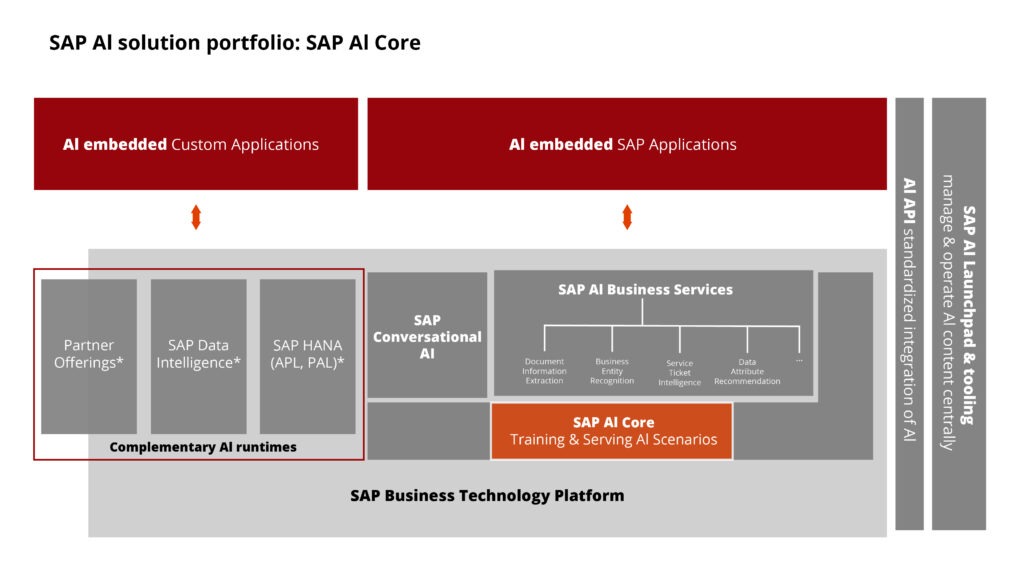SAP AI Overview and Introduction to SAP AI Core

Hey there!!
“Welcome to Part 2 of our blog on SAP’s AI and Sustainability Solution!!”
Our previous blog on SAP AI and Sustainability Solutions with SAP BTP mainly focused on SAP BTP Solutions for AI and SAP Cloud Services for Sustainable Business. Are you excited to read Part 1? Check out the link!!
It’s time to focus on our current blog, but before that, let me ask you a few questions.
- Are you navigating the intricacies of your present system without the ability to leverage AI’s revolutionary potential?
- Is your operational efficiency being impeded by manual processes and data challenges?
It’s critical to assess the limits of your system and investigate solutions that will advance your company in this age of rapid technological advancement. Data silos, laborious tasks, and lost opportunities affect many organizations.
What if intelligence were to be seamlessly integrated to solve these problems and unleash previously unrealized potential?
We present SAP AI, the innovative light that will transform your IT environment.
Artificial Intelligence at SAP
The integration of state-of-the-art technology with unmatched business intelligence through Artificial Intelligence (AI) at SAP signifies a paradigm shift in technical capabilities.
AI, which is fundamentally a mimic of human cognitive processes, opens a new era of efficiency and creativity by enabling machines to learn, adapt, and carry out tasks on their own.
The solid SAP AI Core functions as the organism’s beating heart, coordinating AI features throughout the SAP network. SAP AI Launchpad, a dynamic hub that provides an easy-to-use interface for exploring, deploying, and managing AI applications, is seamlessly integrated with this powerhouse.
After more investigation, SAP AI Business Services is revealed to be revolutionary. Because it contains pre-trained models, businesses can quickly adopt AI without requiring a high level of data science expertise.
The combination of SAP’s machine learning and in-memory database powers SAP HANA ML. With the help of this dynamic duo, businesses can quickly process large datasets and derive insightful information that helps them make well-informed decisions.
SAP Data Intelligence acts as the symphony’s conductor as it navigates the complex world of data integration. It ensures a cohesive, unified data ecosystem by harmonizing disparate data sources.
SAP AI Core Key Components
Below are the key components of SAP AI Core.
- SAP AI Core
- AI API
- SAP AI Launchpad
- SAP AI Core integrated with a 3rd party system
The SAP AI Core, a complex engine that orchestrates intelligent functionalities, is the foundation of SAP’s artificial intelligence capabilities. It acts as the framework, combining easily with other elements to improve the AI experience.
The SAP AI Core and other software applications can communicate with each other through the AI API (Application Programming Interface). With the help of this interface, developers can more easily access AI capabilities and use their power in their applications.
The SAP AI Launchpad makes navigating the AI landscape simple and easy to use. This centralized hub offers a dynamic interface that makes it simple for users to investigate, implement, and oversee AI applications. It’s the preferred platform for utilizing SAP’s AI ecosystem to its fullest.
Business AI is a powerful tool using machine learning to transform how companies operate. Imagine AI analyzing data to predict sales, personalize marketing, automate tasks, and optimize operations. It can improve decision-making, boost efficiency, and unlock new opportunities. From chatbots to fraud detection, AI is already in action across industries. While ethical considerations exist, BAI offers a competitive edge for businesses ready to embrace the future.
Machine Learning workflow
Without explicit programming, machine learning (ML), a subset of artificial intelligence, allows systems to recognize patterns in data and gradually improve performance. It involves developing algorithms with the ability to generalize from examples.
➔ Finding a challenge or issue that can benefit from data-driven insights is the first step in the machine learning workflow. During this first stage, the goals must be defined, and the complexities of the problem domain must be understood.
➔ Finding the AI strategy most appropriate for the task at hand is an essential next step. Choosing the appropriate method is crucial for achieving success, be it supervised learning for labelled data, unsupervised learning for unlabeled data, or reinforcement learning for decision-making.
➔ After determining the challenge and selecting the AI solution, the ML workflow moves on to the more in-depth stages. These usually involve gathering pertinent datasets and preparing them for analysis through preprocessing and data collection.
➔ The next step is Feature Engineering, which involves taking significant features out of the data to improve model performance.
➔ The next steps are model selection and training, which include selecting a suitable algorithm and repeatedly modifying model parameters to maximize performance. Evaluation verifies that the model satisfies predetermined standards by evaluating its efficacy and accuracy.
➔ The last step includes monitoring to ensure continued performance and handle any new challenges, as well as deployment, which involves integrating the trained model into the operational environment.
Use Case
A manufacturing company encountered difficulties in their production line’s manual defect detection, which resulted in poor quality and higher operating expenses.
The objective was to use automation to improve productivity and product quality. Real-time defect detection was achieved by implementing an AI and ML solution that leveraged TensorFlow for computer vision.
The model can detect anomalies with a high degree of accuracy because it was trained on a wide dataset of both defective and non-defective products. By drastically reducing manual inspection work, the AI-driven system minimized human error and allowed for faster production cycles.
Consequently, the company saw an increase in operational effectiveness, a decrease in defects, and better product quality.
In addition to resolving the initial issue, the application of AI and ML enhanced customer satisfaction and reduced costs, demonstrating the revolutionary effect of technology on their manufacturing processes.
Let’s conclude
As we come to the end of our SAP AI adventure, keep in mind that the SAP API is your doorway to unlocking the full power of intelligent business solutions. Unmatched innovation, strong functionalities, and seamless integration are what’s in store.
Think of KaarTech as your reliable partner when it comes to implementing SAP AI. KaarTech is the expert, guiding you through the transformative world of SAP AI with a track record of successful implementations.
With 20 years of industry expertise and 500+ global customers, we have extensive experience in SAP services. Thinking about innovation and AI? Think KaarTech!!
Let’s collaborate to open fresh possibilities for productivity, creativity, and corporate excellence. Select KaarTech to be your implementation partner, and start a journey where SAP AI turns into an engine for the growth of your company. Contact us here.
Willing to learn more?
Check out our next blog to understand the essence of SAP AI Core with a peculiar use case.
FAQ’s
What are the key components of SAP AI Core?
The Key components of SAP AI Core are SAP AI Core, AI API, SAP AI Launchpad, SAP AI core integrated with 3rd party tools.
In what ways does SAP AI support decision-making within organizations?
SAP AI facilitates informed decision-making by leveraging advanced analytics, predictive modeling, and machine learning, providing valuable insights that empower organizations to make strategic, data-driven choices with confidence.
Explain the significance of SAP AI in today’s business landscape
SAP AI is pivotal in modern business, driving efficiency, innovation, and competitiveness by automating processes, enhancing analytics, and delivering actionable insights, thus enabling organizations to thrive in the digital era.



